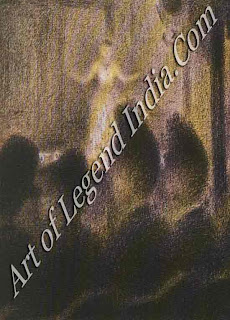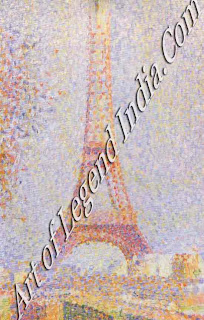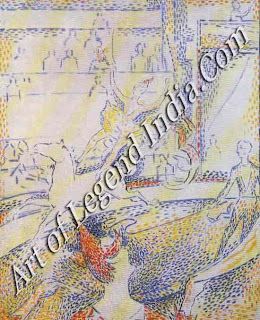The Georges Seurat at work
 A Pattern of Dots
A Pattern of Dots
With
the aid of scientific treatises on colour and his own acute powers of
observation Seurat developed a highly original technique of painting, using
tiny multicoloured dots.
Seurat
is best known today as the artist who devised a painstaking method of painting
in tiny dots. His works as a whole, paintings and drawings alike, are
characterized by their precise and deliberate quality. He left nothing to
chance, never starting a picture unless he knew exactly where he was going. As
one friend remarked later, 'the sensation of being carried away meant nothing
to him'.
Every
day, Seurat shut himself in his little studio, surrounded by his books. There
he could be found perched on a step-ladder in front of one of his canvases some
of them up to ten feet long working in silence, his eyes half closed, a little
wooden pipe held tightly between his teeth. He q. often worked late into the
night, undeterred by the poor artificial light. When he wanted a breath of air.
A MYRIAD OF DOTS
To
begin with, he covered the canvas with a layer of paint. Over this, he painted
a layer of local colours in broad textured strokes. Then he began to build up
the painting using multi-coloured dots, taking small sections of the canvas at
a time and working with incredible concentration. And because he had mapped out
every detail in advance, he rarely needed to step back from the canvas to see
the whole effect.
When
friends came to visit Seurat, they found him reserved and uncommunicative. He
only became animated when they touched upon his ideas or theories. Then he
would climb down from his ladder and, taking up a piece of chalk, eagerly draw
diagrams on the studio floor.
Seurat
did not invent these theories. Rather he studied the aesthetic and scientific
treatises of the day with a view to finding logical explanations for the coloristic
qualities he had already admired in paintings. One of the key notions Seurat
took up was the idea of 'optical mixture'. Instead of mixing his colours on the
palette before placing them on the canvas, which made them lose their
brilliance, he tried placing separate dabs of unmixed colour side by side on
the canvas. He believed that they would then merge in the eye of the spectator,
without any loss of vibrancy. The Impressionists had worked like this
instinctively, but Seurat was able to justify the practice in logical terms.

Seurat
first experimented with this novel technique in a seascape of 1885, painting in
regular dots or dashes to capture more subtle changes in light effects. It was
this technique that was dubbed 'pointillism'. The actual colours of the dots
depended on a number of considerations: the natural colour of the scene before
him, the effect of sunlight or shadow, and the reaction of one colour to
another. By a logical extension of his desire to control the viewer's response,
Seurat began, in 1887, to give his works painted borders.
What
Seurat hoped to achieve through the pointillist technique was not just greater
accuracy, but also the vibration of light itself. He was hampered,
unfortunately, by faulty materials. By the 1890s, his artist friend Paul Signac
could already see serious discolouration and darkening in some of the colours
Seurat had used.
HAPPY AND SAD LINES
From
1887 onwards, Seurat turned his restless intelligence to the problem of line.
He was intrigued by contemporary theories on the directions of lines and the
belief that in painting lines could be used to convey different emotions.
Upward-tending lines were thought to express gaiety, horizontal lines serenity,
and downward lines sadness. He applied these theories in some of his later
works, especially those depicting the artificially high-spirited world of the
circus.

For his
subject matter, Seurat turned his analytical eye on the contemporary world. At
first he deliberately set out to explore Impressionist subject’s suburban
scenes, summer landscapes and seascapes. But unlike the Impressionists, who had
tried to capture the passing moment, Seurat was fascinated by the eternal
moment the timeless grandeur of everyday life. Later he favoured themes in
which people were performing: circus parades, cancan dancers, singers and
clowns. In his early drawings Seurat had made studies of individual figures,
which he reused in his later compositions, but they remain isolated. Even his
crowds are strangely silent.
Seurat's
drawings form an important part of his output described by Signac as 'the most
beautiful painter's drawings that ever existed'. As in his paintings, Seurat
organized and simplified his subject-matter to convey a fixed and lasting
image. He patiently built up tones in small crisscross strokes, using velvety
conte crayon on heavy, rough-textured paper. Often he would isolate a dark
silhouetted figure against a lighter back-ground, or capture the fall of
lamplight on the softened features of a face.
 If
Seurat can be criticized for a certain dryness and impersonality, he was
nevertheless one of the most acute observers of contemporary life. The perfect
balance of harmony and luminosity he achieved has never been equalled.
If
Seurat can be criticized for a certain dryness and impersonality, he was
nevertheless one of the most acute observers of contemporary life. The perfect
balance of harmony and luminosity he achieved has never been equalled.
La Grande Jatte
Seurat began
work on La Grande Jatte in 1884, and spent nearly two years on the immense
canvas. For months on end he visited the little island on the Seined making
studies of the Sunday strollers and the sunny landscape. He worked with complete
concentration, moulding the real Scene into the picture of his imagination when
the grass grew too long at the river's edge, he even asked his friends to cut
it. Eventually Seurat began to build up the final picture in his studio,
skilfully distributing his calm, static figures across the canvas: The finished
work was exhibited in 1886 at the last Impressionist exhibition, where it
provoked an outcry. Seurat's admirers hailed him the 'Messiah of a new art'.
Writer
– Marshall Cavendish
 A Pattern of Dots
A Pattern of Dots  If
Seurat can be criticized for a certain dryness and impersonality, he was
nevertheless one of the most acute observers of contemporary life. The perfect
balance of harmony and luminosity he achieved has never been equalled.
If
Seurat can be criticized for a certain dryness and impersonality, he was
nevertheless one of the most acute observers of contemporary life. The perfect
balance of harmony and luminosity he achieved has never been equalled. 













0 Response to "Frenchish Great Artist Georges Seurat at Work"
Post a Comment